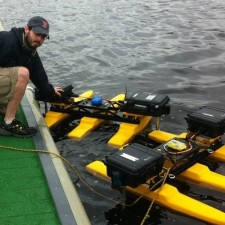Robotics
Marine Autonomy
Marine robotic vehicles—including autonomous underwater vehicles (AUVs), underwater gliders, and autonomous surface vehicles (ASVs)—offer scientists improved access to the ocean, allowing them to measure and better understand marine environments. Marine robotic systems are critical for many defense and industrial applications, including mine countermeasures, surveillance, and environmental monitoring.
Scientists and engineers are now working to deploy numerous networked robotic ocean observatories, expanding the quantity and quality of data available to scientists and to the public worldwide. The ocean environment offers a challenging laboratory in which robotics researchers can develop and evaluate new techniques in sensing, actuation, and autonomous control.
Adaptive and Collaborative Robotic Ocean Sensing
Marine robotic platforms are rapidly evolving to be smaller, cheaper, and equipped with greater sensing and computing power. They are also being designed for longer endurance and better ability to communicate acoustically. Each of these trends furthers the evolution of vehicles from deterministic data-collection missions toward fully adaptive and collaborative missions.
Marine autonomy is a rapidly growing field focused on exploiting on-board sensing and acoustic communications to more effectively explore dynamic ocean phenomena. MIT and WHOI are developing and field-testing new decision-making and communications algorithms on several types of marine robotic platforms.
Marine Autonomy Algorithms and Open Source Projects
Our researchers specialize in the development of new distributed ocean sensing concepts for oceanographic science, national defense, and coastal management and protection. The MIT Laboratory for Autonomous Marine Sensing Systems (LAMSS) hosts an open source marine autonomy project—moos-ivp.org—providing algorithms and software for autonomous decision-making by collaborators in marine robotics research around the world.
LAMSS also hosts software projects in acoustic communication, marine vehicle simulation, post-mission analysis, and high-fidelity ocean acoustic models.
Key Technology Developments
- Autonomy
- Communications
- Cooperative Control
- Mapping
- Navigation
- Sensing







